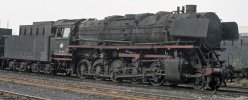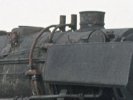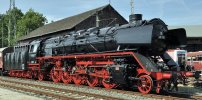You are using an out of date browser. It may not display this or other websites correctly.
You should upgrade or use an alternative browser.
You should upgrade or use an alternative browser.
Odd boiler fittings on a Jumbo
- Thread starter Tim Hale
- Start date
michael080
Western Thunderer
That is a "Riggenbach Gegendruckbremse".
I know that certain BR44s were equipped with such a brake, but I didn't actually see a picture. However, the "chimneys" are basically silencers, very distinct for the Gegendruckbremse and common on all classes. Most classes have only one of these chimneys, I assume the class 44 has two because it is a triple cylinder engine.
See wikipedia for details.
Michael
I know that certain BR44s were equipped with such a brake, but I didn't actually see a picture. However, the "chimneys" are basically silencers, very distinct for the Gegendruckbremse and common on all classes. Most classes have only one of these chimneys, I assume the class 44 has two because it is a triple cylinder engine.
See wikipedia for details.
Michael
Tim Hale
Western Thunderer
Hi,
Thank you,
The penny dropped when you mention Riggenbach.
I believe that the Riggenbach Gegendruckbremse was a counter brake system which was fitted to 044 404 and 427 after the 45s were withdrawn from service. They had been previously used for trials with new locomotives. Somewhere I have/had an image image of a BR150 hauling the two 45s.
In addition, the DR fitted at least one 94 with counter braking on the Ilmenau-Rennsteig line, one the steepest adhesion lines in Germany.
Tim
Thank you,
The penny dropped when you mention Riggenbach.
I believe that the Riggenbach Gegendruckbremse was a counter brake system which was fitted to 044 404 and 427 after the 45s were withdrawn from service. They had been previously used for trials with new locomotives. Somewhere I have/had an image image of a BR150 hauling the two 45s.
In addition, the DR fitted at least one 94 with counter braking on the Ilmenau-Rennsteig line, one the steepest adhesion lines in Germany.
Tim
Osgood
Western Thunderer
A Counter Pressure brake - does what a Jake Brake does on a truck engine, restricts exhaust from cylinders by messing about with the valve settings and creating back-pressure on exhaust cycle. (bet @Eastsidepilot would be upset if the Jake brake had silencers though!).
Despite having been in charge of BR Research's brake department at one time, I had no idea about this, but was intrigued. I knew that it was possible to slow a loco by reversing the direction in which it is travelling (Casey Jones always seemed to do this). This system uses the cylinders to compress clean air, the work done in doing so reduces the train speed. Apparently it also used water injection to keep the cylinders moist during the process. Compressing air results in heat generation (bicycle pump anyone?) so the water helped stop oil residues being burnt off. Useful for long down grades.
michael080
Western Thunderer
Just as David says. There are two more details to mention:
-- The intakes needed filters to avoid dirt being sucked into the cylinders
-- and the big advantage of this brake system is that it is more effective at higher speeds.
-- The intakes needed filters to avoid dirt being sucked into the cylinders
-- and the big advantage of this brake system is that it is more effective at higher speeds.
Tim Hale
Western Thunderer
Having mentioned the use of 45s by DBs test department, it might be of interest to post an image of the last remaining example.
This is 45 010, it spent it last few years with 45 019 as counter braking locos based at either Munich or Minden. In 2005, it was badly scorched by the disastrous fire at the Nurnburg museum site and given a cosmetic overhaul at Meiningen but there are hopes that it will steam once more. Currently housed at the old Lichtenfels depot, a wee bit north of Bamberg, it is not on public display.
The 45s were designed to haul very heavy freights at higher speeds than the 44s (in the OP), they were successful but only 28 were built. The 44s were not unknown to be rather fleet of foot (we unsuccessfully* tried to keep up with one beside the Moselle) so a 45 must have been a bit of a beast.
Tim
*The Morris was unhappy over 65
This is 45 010, it spent it last few years with 45 019 as counter braking locos based at either Munich or Minden. In 2005, it was badly scorched by the disastrous fire at the Nurnburg museum site and given a cosmetic overhaul at Meiningen but there are hopes that it will steam once more. Currently housed at the old Lichtenfels depot, a wee bit north of Bamberg, it is not on public display.
The 45s were designed to haul very heavy freights at higher speeds than the 44s (in the OP), they were successful but only 28 were built. The 44s were not unknown to be rather fleet of foot (we unsuccessfully* tried to keep up with one beside the Moselle) so a 45 must have been a bit of a beast.
Tim
*The Morris was unhappy over 65
Last edited:
simond
Western Thunderer
Well, every day is a school day…
Google translate is much better than Simon translate (and much quicker too). (But probably less fun in a bierkeller)
 de-m-wikipedia-org.translate.goog
de-m-wikipedia-org.translate.goog
and my heretofore poor understanding of Jake brakes is now improved!
thx
Google translate is much better than Simon translate (and much quicker too). (But probably less fun in a bierkeller)
Gegendruckbremse – Wikipedia
and my heretofore poor understanding of Jake brakes is now improved!
thx
That's a very handsome loco.Having mentioned the use of 45s by DBs test department, it might be of interest to post an image of the last remaining example.



